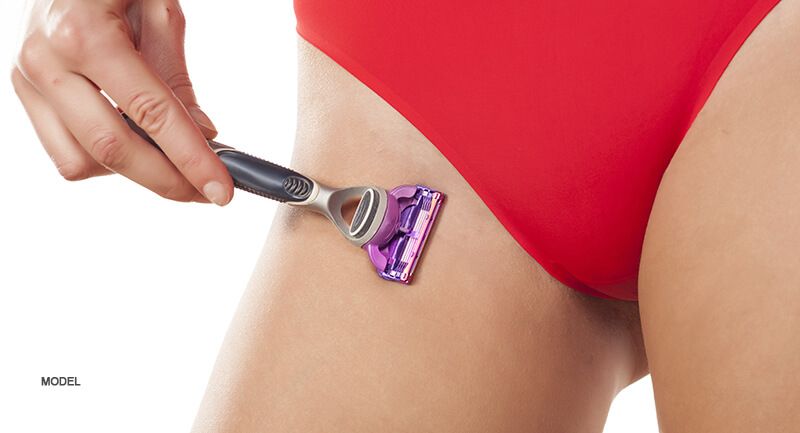Folliculitis: Symptoms, Causes, Prevention, and Treatments

Folliculitis is a general term for a group of conditions that relate to infected or inflamed hair follicles along the skin. It’s one of the world’s most common skin conditions, affecting men and women of all ages. In this blog post, we will discuss Folliculitis in detail including common causes, preventative measures, and treatment options.
What is Folliculitis?
When a hair follicle is clogged or infected, folliculitis develops. Clogs leading to folliculitis most often occur as the result of ingrown hairs (often referred to as razor bumps). Infection may also be the result of bacteria, fungi, or a virus.
At first, the condition may appear as small red bumps or it might look like acne. There are several types of folliculitis, and symptoms can include the following:
- Small red or white bumps on hair follicles
- Pimples, blisters or sores on hair follicles
- Itching, stinging or burning skin
- Skin that’s sensitive to touch or painful
Is Folliculitis Harmful?
Folliculitis is not particularly dangerous, but it can be uncomfortable or painful. Folliculitis on the face, arms or hands can be embarrassing.
Left untreated, sores may form pustules, or infections may go deeper, leading to scarring or areas of permanent hair loss.
In patients with compromised immune systems (on steroids, immunosuppressants, etc.), it is important to get treatment to prevent the infection from spreading and becoming more serious.
Where On the Body Does Folliculitis Occur?
Folliculitis can occur anywhere on the body where there is a hair follicle. Most often, it occurs in areas subjected to shaving, chafing against clothing, or trapped sweat. It’s common to experience folliculitis on the following areas:
- Face
- Neck
- Back
- Underarms
- Thighs
- Buttocks
What is Superficial Folliculitis vs Deep Folliculitis?
There are many types of folliculitis, each is classified based on its cause or presenting symptoms. The two main categories of folliculitis are superficial and deep.
Superficial Folliculitis
Superficial folliculitis is generally classified based on what caused it. This type of folliculitis affects only one part of the hair follicle. There are four main types:
- Bacterial Folliculitis: The most common form, also known as a staph infection
- Pseudomonas Folliculitis: Named for bacteria found in hot tubs
- Pseudofolliculitis Barbae: Razor bumps linked to ingrown hairs
- Pityrosporum Folliculitis: Typically occurs with yeast infections
Deep Folliculitis
Deep folliculitis affects the entire hair follicle. This type is generally named for its symptoms.
- Sycosis Barbae: Red pus-filled bumps that appear similar to cystic acne may lead to scarring.
- Gram-Negative Folliculitis: Acne that gets worse as a result of long-term antibiotic use.
- Eosinophilic Folliculitis: Itchy, pus-filled bumps resulting from a compromised immune system.
- Boil: A sensitive or painful red bump, the result of deep infection.
- Carbuncle: A cluster of several boils.
Causes of Folliculitis
Folliculitis commonly occurs as a result of daily activities that leave hair follicles prone to getting clogged or infected. This includes the following:
- Shaving often, shaving with dull razors, or shaving in unsanitary conditions
- Soaking in hot tubs which haven’t been properly cleaned
- Excessive sweating, or remaining in wet clothes too long
- Skin chafing due to tight clothing or obesity
- Long-term use of oral antibiotics
- A history of diabetes
How is Folliculitis Diagnosed?
Generally, folliculitis can be diagnosed with a visual exam and a few brief questions about your shaving habits or how and when the bumps appeared. In more severe cases, your doctor or dermatologist will order diagnostic tests such as skin swabs or biopsies to identify the specific cause and best course of treatment.
Preventing Folliculitis
If you’re prone to folliculitis, consider the following preventative methods:
- If you shave, stop. Switch to a more long-term form of hair removal that is less likely to cause ingrown hairs. Laser hair removal is a good option.
- If you must shave, do so with care. Always start with clean skin and a fresh razor. Before shaving, soak skin in warm water to open pores. Use a lubricating shaving gel or cream to soften hairs and minimize irritation. Apply a moisturizer immediately after shaving to keep skin well hydrated. Stick with bland moisturizers without fragrances (Cerave, Cetaphil, Aveeno, Vanicream). Try and shave with the direction of hair growth (not against the grain). Consider shaving in the shower with a fog-free mirror. This gives the skin pores time to open up and lather shaving cream on.
- Keep skin dry. After sweating, immediately change into clean, dry clothes. Avoid soaking for too long in hot tubs or steam rooms unless you’re certain they are regularly cleaned.
- Keep skin hydrated. Use moisturizing lotion after showering, bathing or shaving.
- Keep skin clean. Clean small cuts or sores immediately to prevent infection.
- Keep towels and bedsheets clean. Regularly wash towels and bedsheets. Hang towels to dry after each use.
- Avoid friction. Wear loose, breathable clothing in areas prone to infection or inflammation.
Folliculitis Treatment Options
Most cases of folliculitis respond well to treatment. Treatments may include topical creams or, in cases of deeper infection, oral medication. Deep folliculitis may require surgical draining. Your doctor may recommend any of the following treatments:
- Topical antibiotic or antifungal treatments
- Oral antibiotics, antifungals, or antiviral treatments
- Topical or oral steroids to address inflammation
- Surgical drainage for large boils or carbuncles
- Warm compress to reduce pain or discomfort
Most cases of superficial folliculitis can be resolved with home treatment. If you believe you have deep folliculitis, or if your condition is painful or worsening, see your dermatologist for diagnosis and treatment.
It is always best practice to see your dermatologist for a definitive diagnosis and treatment plan.
Disclaimer: The contents of the Westlake Dermatology website, including text, graphics, and images, are for informational purposes only and are not intended to substitute for direct medical advice from your physician or other qualified professional.
